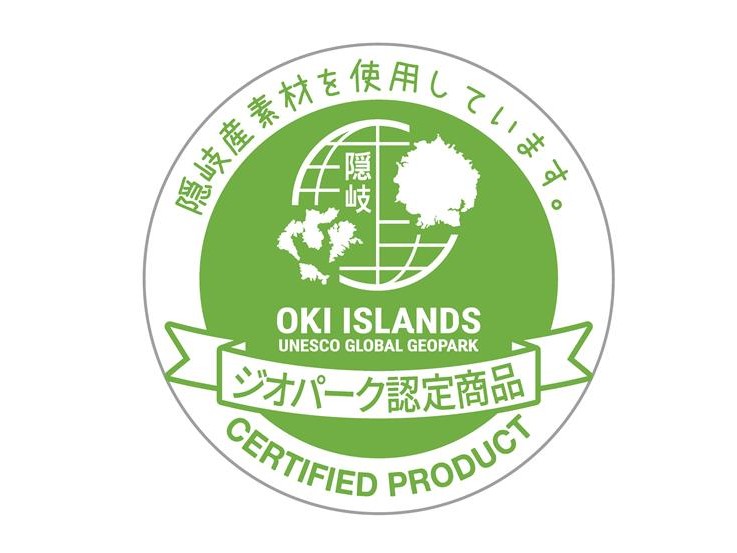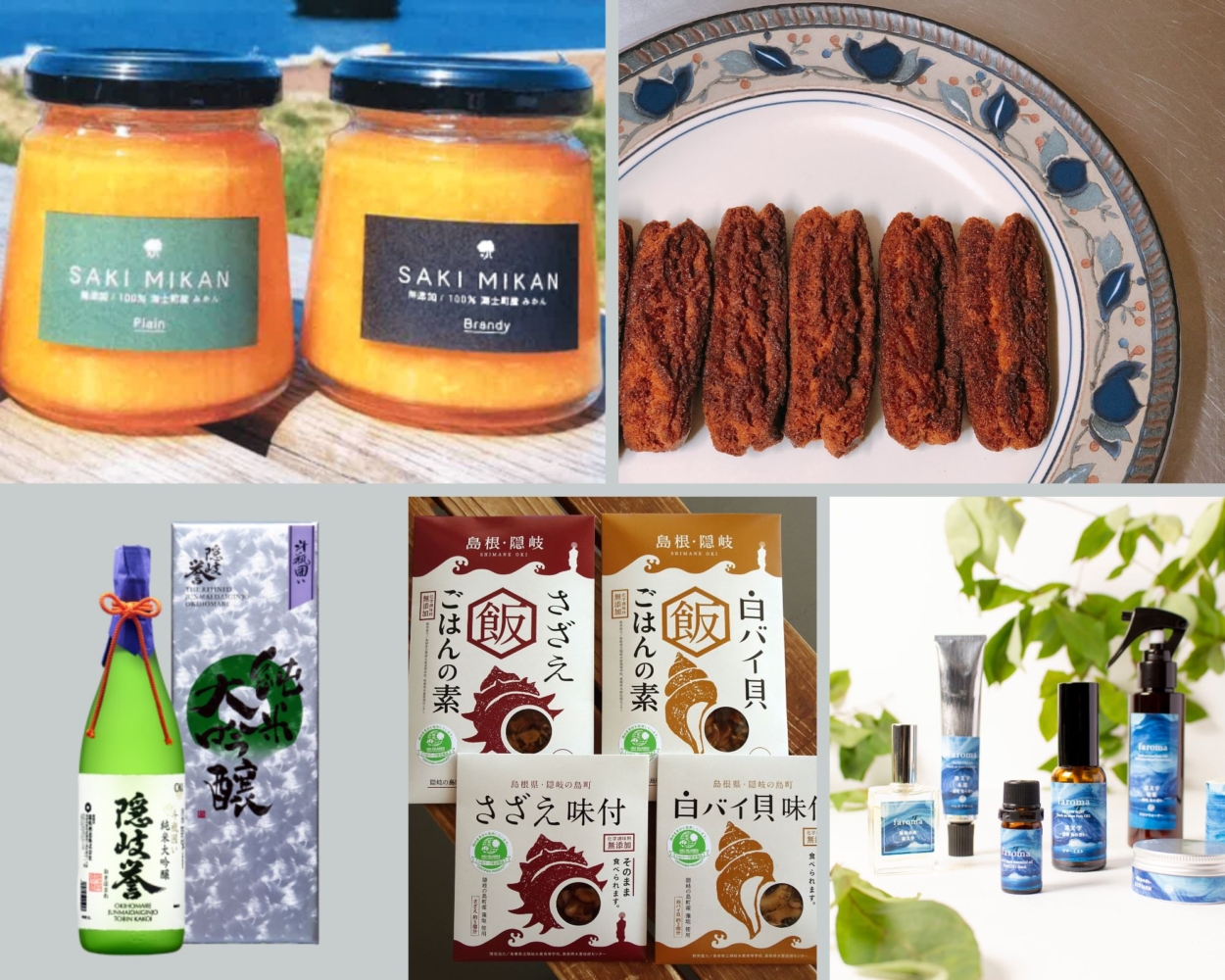Sweets
Oki Islands have much to say in regards to confectionery. Local businesses expertly deliver traditional Japanese sweets and don’t shy away from Western-style treats.
Sazae Monaka
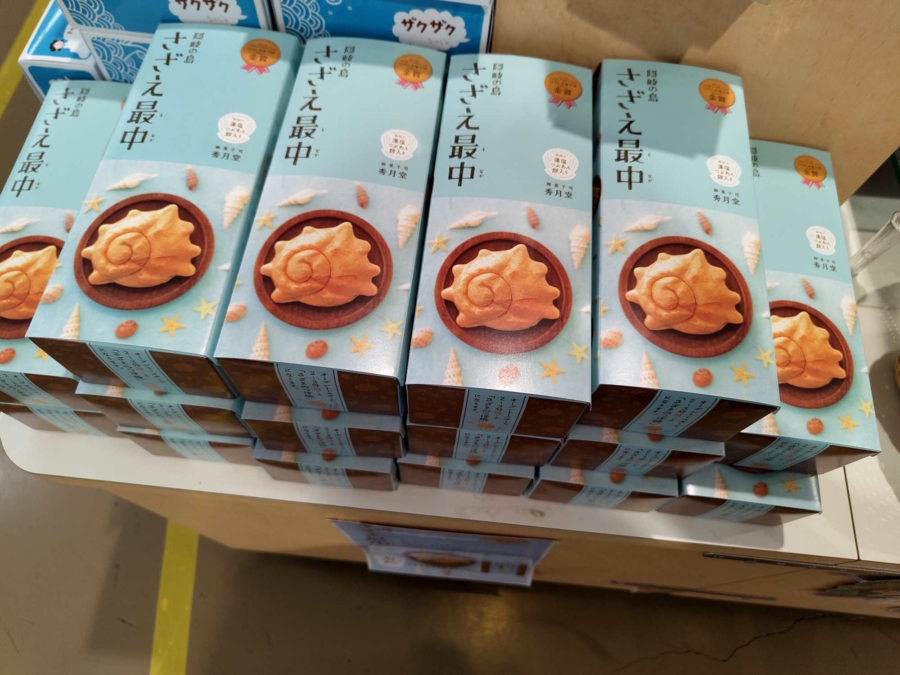
Can’t get enough of sazae turban shell, a local delicacy from the Oki Islands?
Or perhaps the exact opposite―can’t say that seafood is your cup of tea?
Whichever is the case, look no further! Sazae Monaka, a traditional Japanese confectionary shaped like a turban shell, is sure to delight you. Made with bean paste and rice cake enclosed in a wafer, it can be enjoyed on its own or paired with a hot beverage. Some like to pop it into a toaster oven for a minute or three to have the wafer crispy and rice cake slightly melted. Local people jokingly call this a “turban shell grilled in its shell”.
When in doubt or overwhelmed by the selection at a souvenir shop, you cannot go wrong with Sazae Monaka.
- Where can you buy it?
Okinoshima Town: Shugetsu-dō, Saigō Port Souvenir Shop, Sunterrace Shopping Center
Online: https://boso-seieido.com/product/sazae/
Oki Shimadeleine
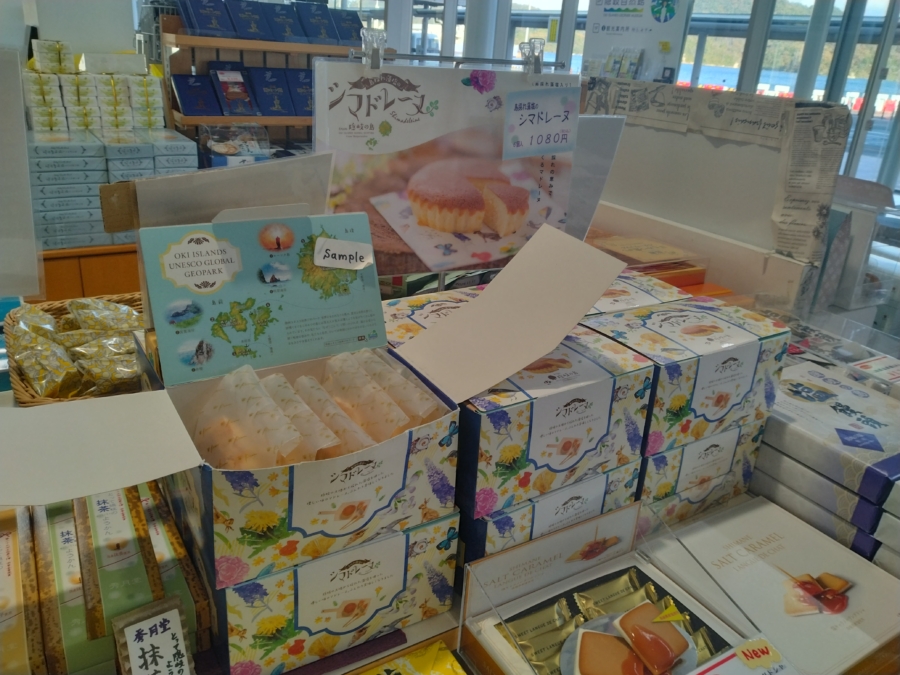
These sweet little sponge cakes are bound to evoke powerful memories of the Oki Islands. Their taste carries a hint of moshio salt, a salt produced locally from saltwater and seaweed. The package design is more or less a crash course on the natural wonders of the islands. Opening the box reveals pictures of unique plants and animals, Oki obsidian and a map of the islands. Credit for this packaging goes to the local junior high school students, who have learnt about their local area during classes on the geopark and put their newly found knowledge into this creative work. And they also shared a piece of advice―delicious as the sponge cakes are straight out of the wrapper, 20 seconds in a microwave makes them pleasantly soft and moist.
Between moshio salt producers, local students’ involvement in its design and the Oki Islands Geopark Management Bureau’s support through its Packaging and Design subsidy, Oki Shimadeleine is the fruit of the community’s collective efforts. Perfect for a gift from the islands!
- Where can you buy it?
Okinoshima Town: Shugetsu-dō, Saigō Port Souvenir Shop, Sunterrace Shopping Center, Ankichi Market
Nishinoshima Town: Ando-honten
Iguri
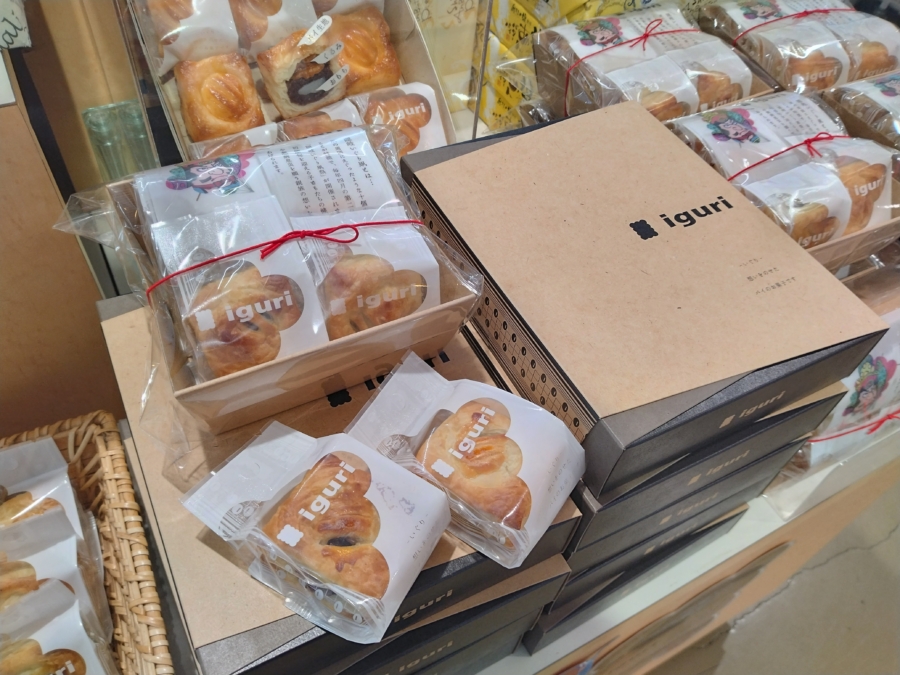
Iguri is the signature pastry of a confectionary shop in Okinoshima Town. One bite reveals a rich filling of a rice cake in red bean paste and topped with a piece of walnut. Bought individually, they are a delight as a quick snack or casual souvenir; a box of four or six makes for a wonderful gift.
But Iguri is more than a pastry―it is a homage to the local custom of making and flying iguri-dako, or curiously shaped kites. In Okinoshima Town, people send them to the skies in early spring to pray for their newborns’ health and good fortune. Information on this tradition is printed on the packaging of the pastry alongside the silhouette of the kite.
- Where can you buy it?
Okinoshima Town: Saigō Port Souvenir Shop, Oki Airport
Oki Homare Sakekasu Cake and Crackers
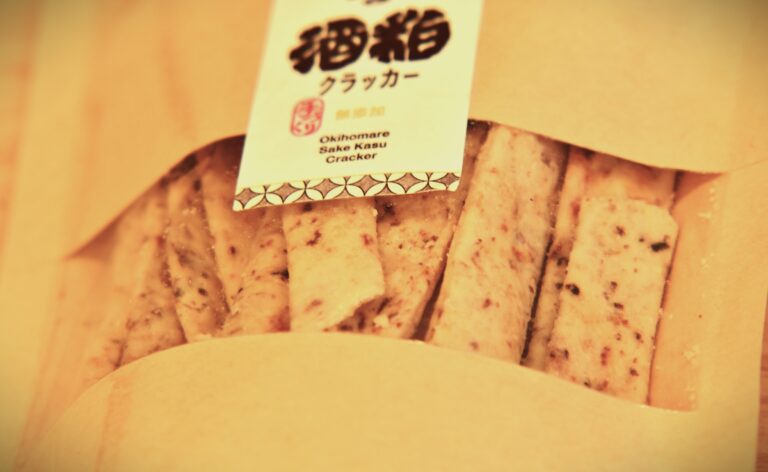
What happens when a former brewery turned souvenir shop and a bakery in Nishinoshima Town join forces?
The answer is Oki Homare Sakekasu Cake and Crackers. They are made with sake-less, pressed sediments left from the production of locally brewed alcohol. Not to worry, though! While these baked goods retain the flavour, neither contain any actual liquor.
The cake goes well with tea, coffee and (no surprise here) a cup of local sake. The crackers are a perfect snack, satisfyingly crunchy and vaguely tasting of cheese. Both are sold in simple yet elegant packaging created with support from Oki Islands Geopark Management Bureau. The design features a tile pattern that also adorns the facilities of Ando-honten―a nod to the souvenir shop mentioned above.
- Where can you buy it?
Okinoshima Town: Saigō Port Souvenir Shop, Kyōmiya-bunten
Nishinoshima Town: Ando-honten
Kinnya Monya Manjū
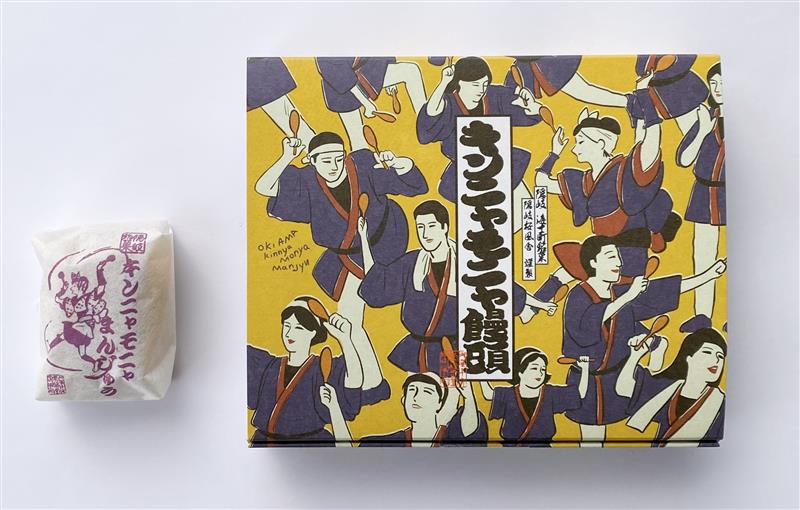
These tiny buns filled to the brim with sweet bean paste are a shining example of traditional Japanese confectionery. And since they were made in Ama Town, they bear the name of the beloved local folk song. Literary―the characters for “Kinnya Monya” are written across not only the box but on the 12 manjū contained within as well. This packaging was designed with the financial support from Oki Islands Geopark Management Bureau.
While Japanese confectionary is often served with green tea, you can enjoy the honey-like sweetness of these buns on their own. When in doubt about what to bring back as a gift from Oki Islands, you cannot go wrong with Kinnya Monya Manjū.
- Where can you buy it?
Ama Town: Tsunakake, Kinnya Monya Center
Ama Shamoji
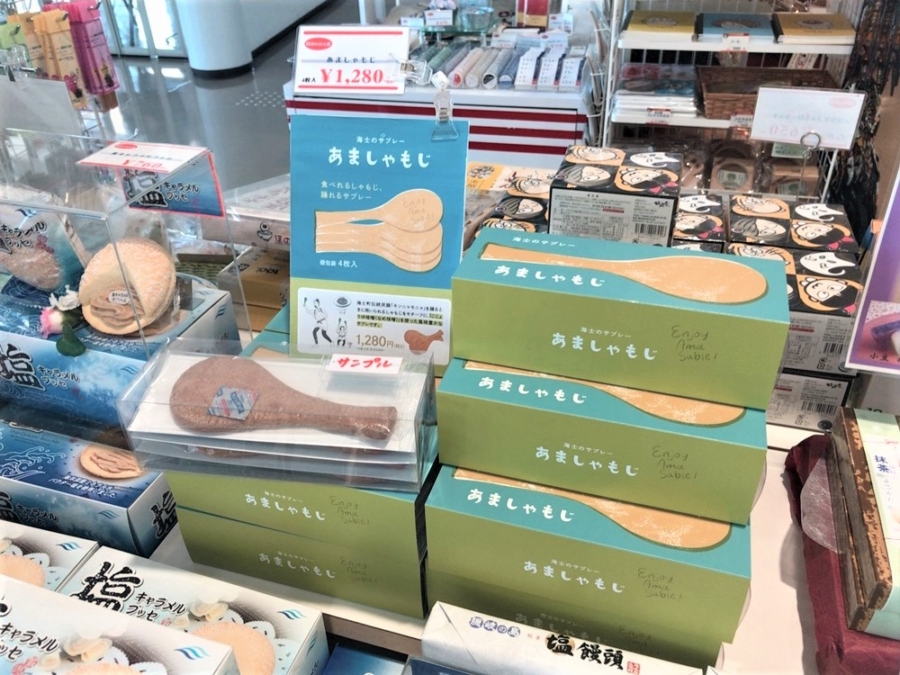
Is it a spoon? Is it a knife?
No, it’s a shortbread cookie! One baked into the same shape and size as a rice scoop, that is. Sold in a box of four, Ama Shamoji is a sweet and salty treat seasoned with miso―the kind islanders make at home themselves.
―Why the shape, though?
While a common household item, the rice spoon holds cultural significance in Ama Town. Local people wield one in each hand when dancing to their beloved folk song “Kinnya Monya”. According to the information on the package, designed with support from Oki Islands Geopark Management Bureau, it is perfectly alright to perform to this tune holding shortbread cookies, too.
To sum it all up, Ama Shamoji is a wonderful souvenir from Ama Town, perfect for those who appreciate the island’s culture and good humour.
- Where can you buy it?
Ama Town: Tsunakake, Kinnya Monya Center
Nishinoshima Town: Ando Hoten
Shiranami
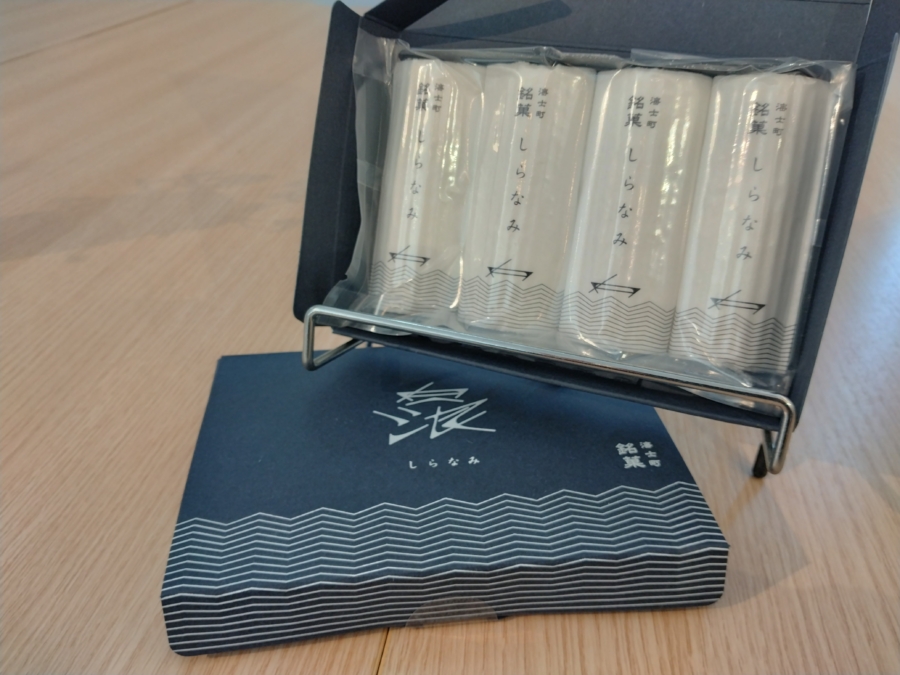
Shiranami proudly represents a unique confectionary, the kind rarely seen elsewhere in Japan. Its key ingredient is kanbaiko, a flour made when thinly sliced rice cakes are baked and then ground to a fine powder. This flour is mixed with sugar and water to form a skin, then wrapped around smooth sweet bean paste and molded into a shape reminiscent of the waves washing over the shores of the Oki Islands as a finishing touch. The entire manufacturing process is done by hand and takes place in Ama Town.
Mind its shelf life, which is a bit shorter than most other sweets. It is best to indulge in Shiranami sooner rather than later. This should not be a problem: between its pleasant sweetness and interesting texture, it quickly disappears. Also, when served with yoghurt or vanilla ice-cream, it becomes a truly decadent dessert.
Shiranami is sold in a box of eight and a new, elegant package. Since it is available only in Ama Town, it makes a wonderful, thoughtful gift from this island.
- Where can you buy it?
Ama Town: Tsunakake, Kinnya Monya Center
Online: https://okiofusha.thebase.in/items/38984687
Lemon cake
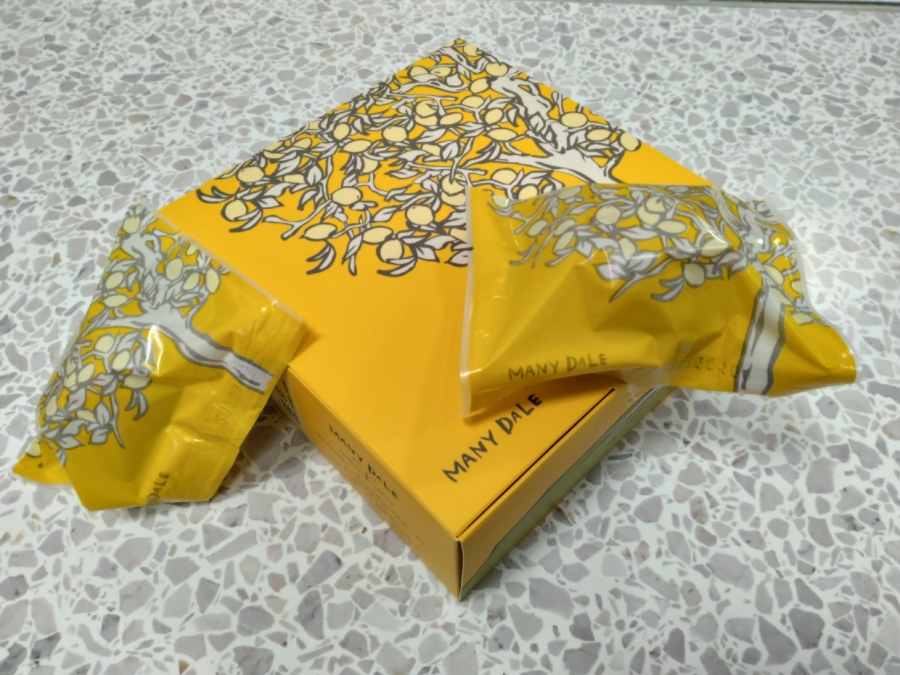
With this citrusy goodness, a small bakery in Chibu Village proved once and for all that pastry and lemon icing are a match made in heaven. The taste perfectly balances sweet and sour flavours, with a texture similar to Shimadeleine from Okinoshima Town. And did you notice that the cake is shaped like a lemon?
The cakes are available individually or in a box of six. Paired with a beverage of choice, they are a treat worthy of any guest (or yourself). No wonder local people themselves buy lemon cakes as souvenirs for friends and family living elsewhere in Japan!
- Where can you buy it?
Chibu Village: Tourism Association
Ama Town: Kinnya Monya Center
Nishinoshima Town: Many Dale (Beppu Port Terminal 2nd floor), Ando Honten
Okinoshima Town: Oki Airport
Shima Tofu Doughnuts
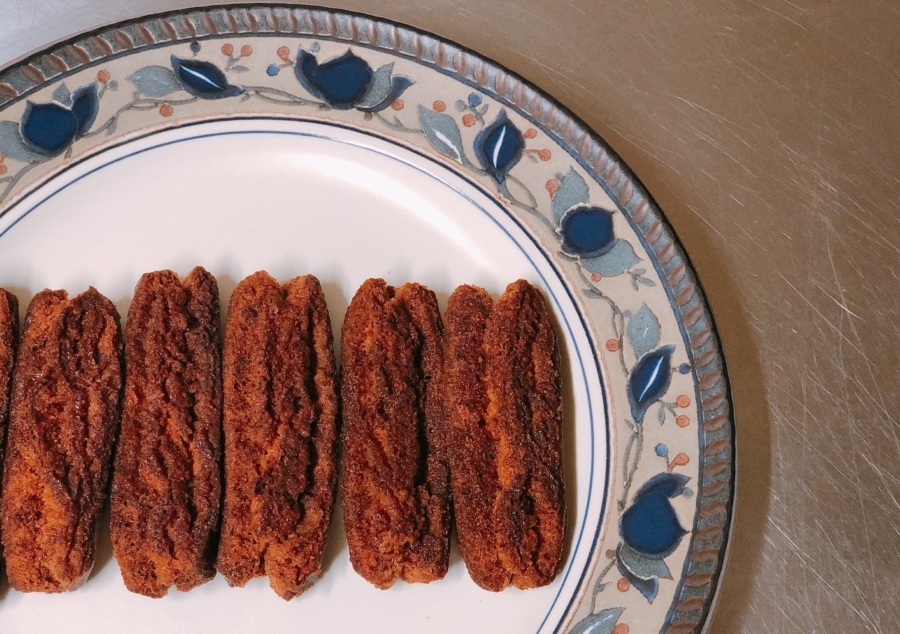
Shima Tofu Doughnuts are another signature product of a small bakery in Chibu Village. They are made with tofu from neighbouring Ama Town and sold in a box of eight.
Those expecting round doughnuts might be surprised to see oblong pastries. The non-conventional shape makes them no less delicious, though. Their moderate sweetness is courtesy of brown sugar on the ingredients list, and they are great served on their own or with a cup of coffee. On the scale from chewy to crunchy, they lean toward the crunchy.
If you are looking for a Western-style confectionery with a unique Oki Islands twist, Shima Tofu Doughnuts are the souvenir for you. Perfect as a gift and a snack!
- Where can you buy it?
Chibu Village: Tourism Association
Ama Town: Kinnya Monya Center
Nishinoshima Town: Many Dale (2nd floor of Beppu Port Terminal), Ando Honten
Okinoshima Town: Oki Airport, Saigō Port Souvenir Shop
Fukugi Ame
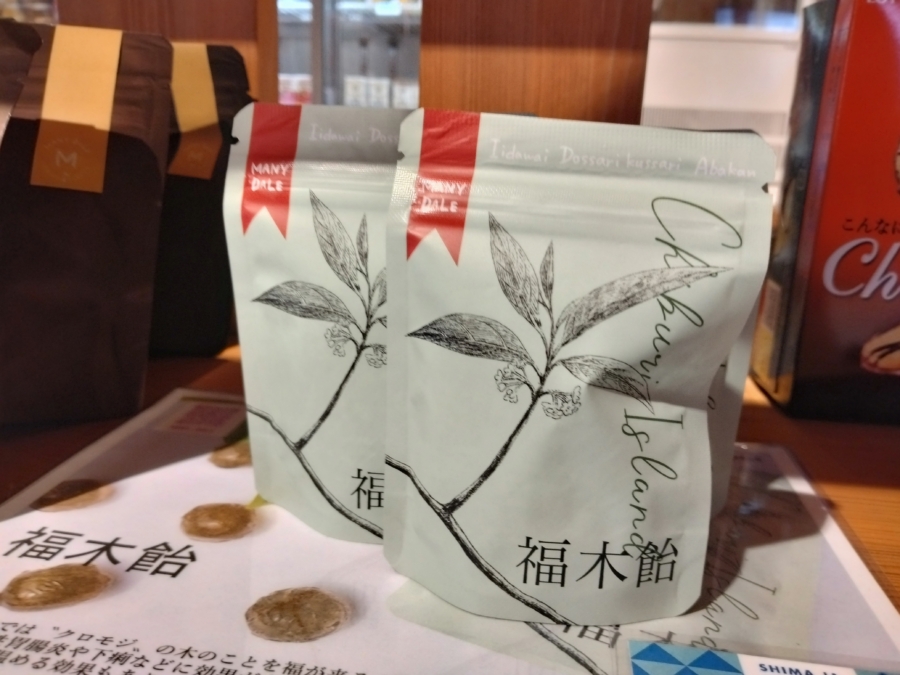
First things first―what’s fukugi?
In a nutshell, fukugi is a type of aromatic, evergreen shrub in the Lindera genus. Local people swear by its many health benefits and find the scent relaxing. Outside of the Oki Islands, it goes by the name kuromoji.
This plant has seen a resurgence in recent years, with quite a variety of newly developed products that incorporate its parts or essential oil. One of them is Fukugi Ame, boiled sweets made with dried fukugi leaves ground to a fine powder. With a taste more on the savoury side, they are an interesting alternative to your typical fruit-flavoured drops. Sold in a small packet, they are great as a casual souvenir.
- Where can you buy it?
Chibu Village: Tourism Association
Ama Town: Kinnya Monya Center
Nishinoshima Town: Many Dale (2nd floor of Beppu Port Terminal)
Okinoshima Town: Sunterasse Shopping Center
Saki Mikan Jam
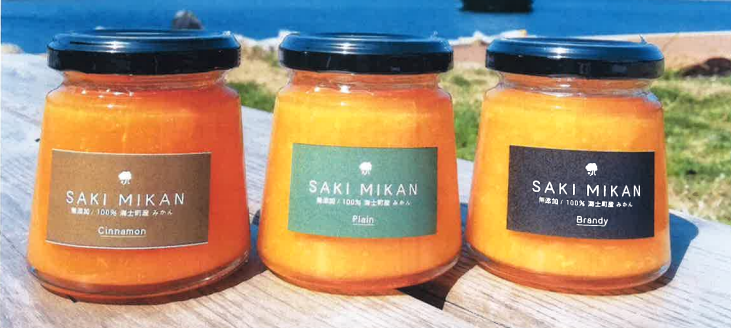
The project restoring tangerine cultivation in Saki Area, the southernmost part of Ama Town, bore many fruits (pun intended), one of them being Saki Mikan. This jam perfectly balances natural sweetness with citrusy tartness and is surprisingly versatile. It can elevate your breakfast or teatime, spread on a piece of toast or mixed with tea instead of ginger. It pops up on the list of ingredients in local cafes’ delicious cakes and desserts. And some people even add it to their ginger pork dishes for more flavour. Locally sourced, produced and beloved, Saki Mikan is a certified product of Oki Islands UNESCO Global Geopark.
The jam is not available all year round. Souvenir shops have it stocked in winter and spring, but it tends to sell out by summer.
- Where can you buy it?
Ama Town: Kinnya Monya Centre, Tsunakake
Savoury Products
With any of these products you can easily recreate your Oki culinary experiences at home or gift your loved ones with flavours of the islands.
Natural Dried Wakame
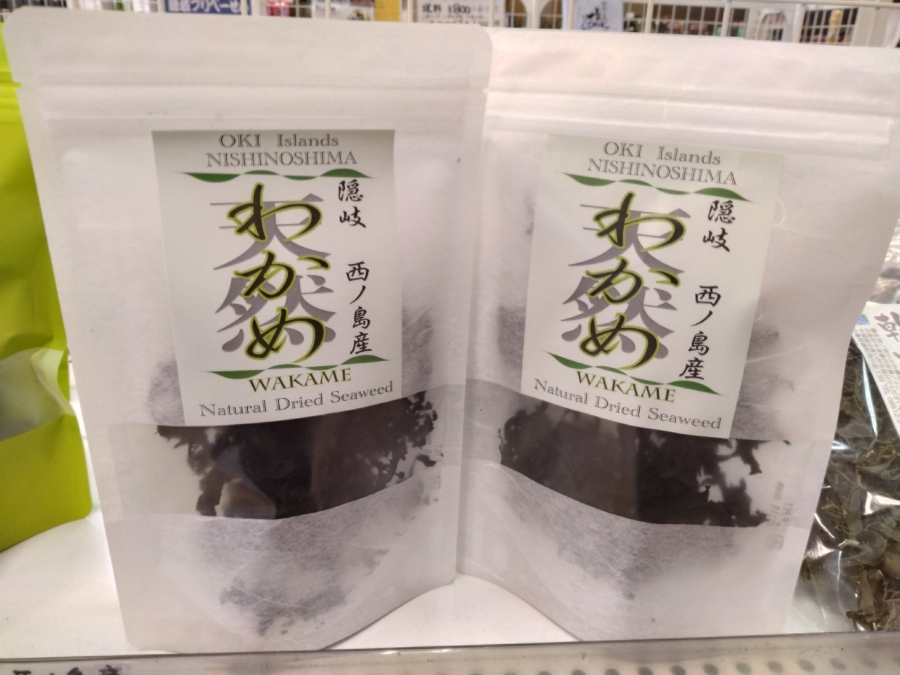
Wakame is the leafy part of kelp. Mild in taste, soft in texture and rich in nutrients, it is harvested in spring, then cut into thin strips, dehydrated and made available for purchase. While local people often enjoy it fresh, they buy the dried version as a gift for friends and family from outside the islands.
How can you serve it, though?
As expected, the islanders can recommend several ways.
For example, dried wakame can be mixed with hot rice or crumbled and sprinkled atop a rice bowl. If you rehydrate it, you can add it to your miso soup or use it as a topping for your ramen noodles. Alternatively, you can season it with soy sauce, mirin, ginger, salt and some rice wine and enjoy it in a salad.
- Where can you buy it?
Nishinoshima Town: Ando Honten, Sakuraya, Kuniga-so, Marin, Oki Seaside Hotel Tsurumaru, Nishiwaki Fishery Shop, Yamazaki Shop
Natural Dried Mekabu
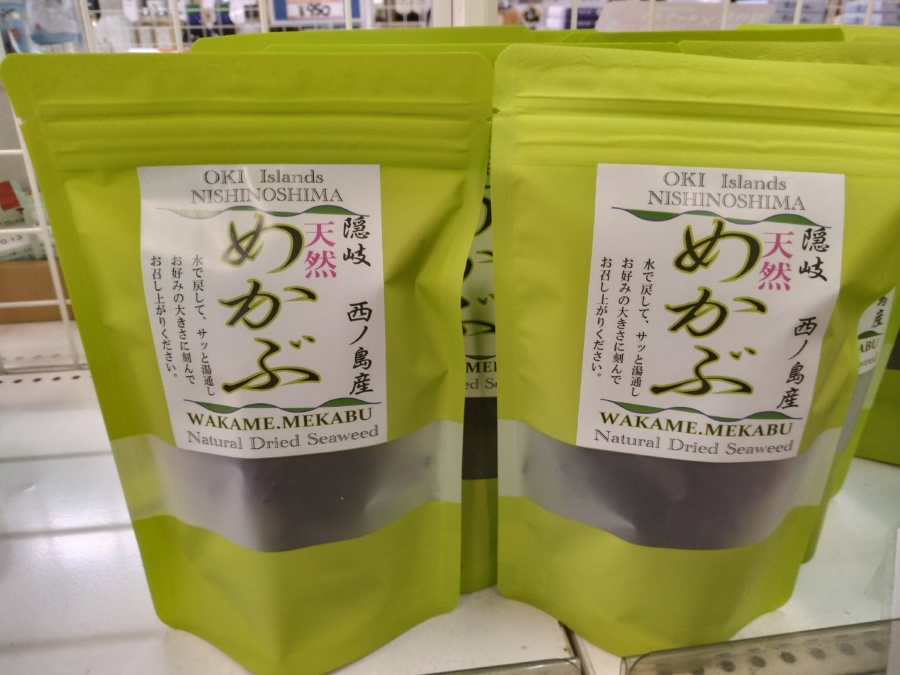
Here is an interesting piece of seaweed trivia: wakame and mekabu are different parts of the same kelp. While wakame is the “leaves”, mekabu is the stem-like, bottom part of the plant. Once harvested, both are processed similarly, though mekabu is not cut into smaller pieces. It is less widespread in Japanese cuisine than wakame and, for foreigners, it can be a bit of an acquired taste.
That being said, local people enjoy mekabu for its interesting, slightly crunchy texture and recommend using this seaweed as a topping for rice. First, you rehydrate it, then thinly slice or mince it in a food processor. Finally, it is ready to sit on its throne of rice. You may add a raw egg yolk on top to indulge in a textbook mekabu rice bowl.
- Where can you buy it?
Nishinoshima Town: Ando Honten, Sakuraya, Kuniga-so, Marin, Oki Seaside Hotel Tsurumaru, Nishiwaki Fresh Fishery Shop, Yamazaki Shop
Canned Sazae Turban Shells
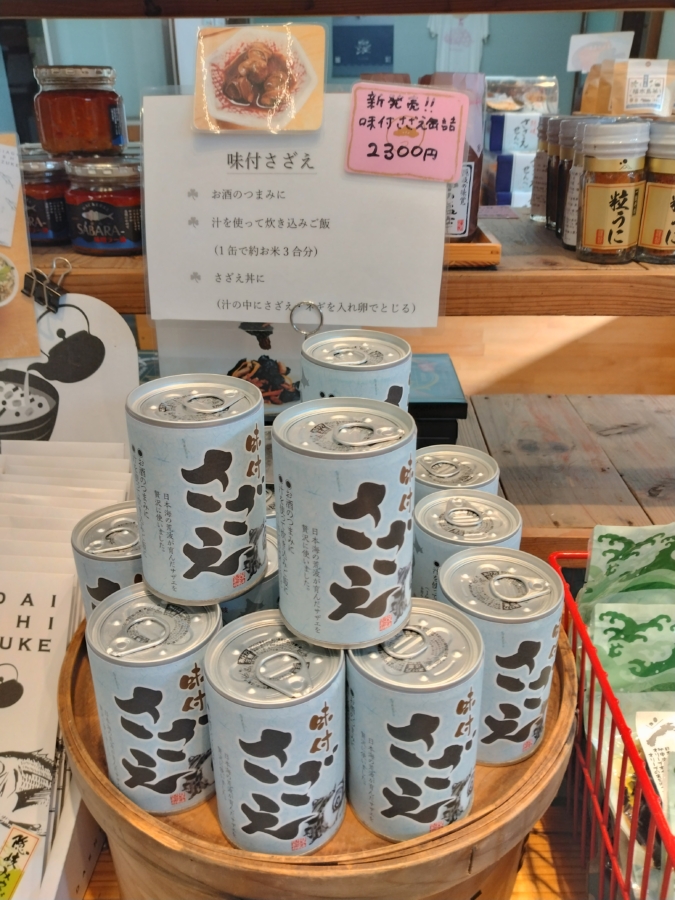
If you have visited the Oki Islands, chances are you indulged in its signature marine produce―sazae turban shells. Would you like to bring some back with you?
If your answer is a resounding yes, you will be pleased to know that a small business in Nishinoshima Town has your back, offering canned turban shells in soy sauce-flavoured broth. They are locally sourced, processed and ready for use. Straight out of the can, turban shells are a sophisticated snack for an evening drink, be it rice wine or a beer. It is also delicious when cooked with rice, sliced carrot and shiitake mushrooms.
Since turban shells are harvested in July, a new batch of the product hits the shelves in summer and is available until it sells out.
- Where can you buy it?
Ama Town: Tsunakake
Nishinoshima Town: Anto Honten, Sakuraya, Marin, Nishiwaki Fresh Fishery Shop
Makino Fisheries, Seafood Products

Through their combined efforts, a fisherman-slash-business owner in Okinoshima Town and students at the local Oki Fishery High School developed not one, but two lines of products: Ajitsuke and Gohan-no moto. The former offers processed sazae turban shells or shiro-baigai whelks, seasoned with seaweed salt and ready to serve. You can eat them as they are straight out of the package or have them as a side dish. The latter is a seasoned mixed rice base with pieces of either turban shell or whelk in a flying fish stock with seaweed salt and a dash of rice wine from Oki Sake Brewery. Cooked with about 300 ml of rice, it makes a grand meal for 2-3 people that is rich in the flavours of Oki Islands.
As expected from products certified by Oki Islands UNESCO Global Geopark, all the ingredients used for Ajitsuke and Gohan-no moto are locally sourced and include absolutely no additives.
- Where can you buy it?
Okinoshima Town: Saigō Port Souvenir Shop, Anki-ichi Market
Makino Fisheries, Canned Seafood Dishes
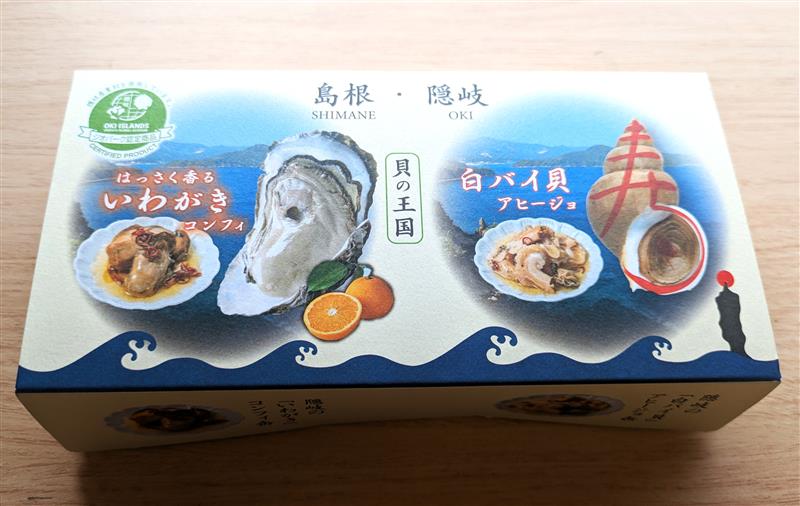
Whoever said that canned food cannot be luxurious has never seen (nor tried!) the Whelk Ajillo and Rock Oyster Confit by Makino Fisheries. The seafood is top-notch, freshly caught and delicious. In ajillo, olive oil compliments the whelk and Candle-Island Seaweed Salt proves itself a perfect condiment of choice. With the Rock Oyster Confit, locally sourced hassaku zest hits the mark just right.
Indulging in the canned goods, you can feel the care islanders have put into preparing these dishes, from fishermen and farmers to the employees manning local processing facilities. It comes as no surprise they are certified products of Oki Islands UNESCO Global Geopark.
- Where can you buy it?
Okinoshima Town: Saigō Port Souvenir Shop, Anki-ichi Market
Oki Islands Oysters and Rock Oysters
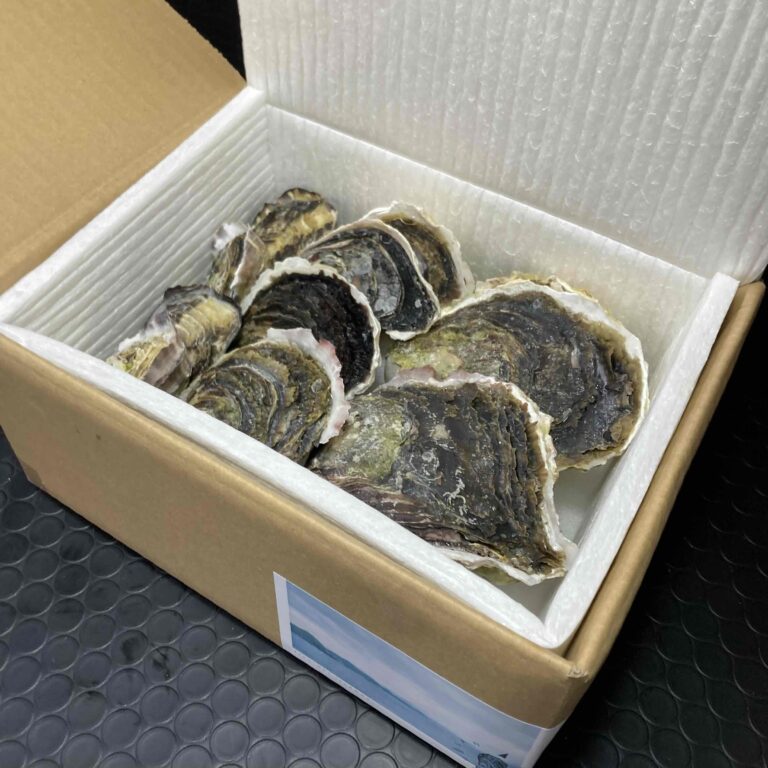
If there is produce that can make a person fall in love with seafood, it is the Oki Islands Oysters and Rock Oysters. Iseki Fisheries, a small business in Okinoshima Town, lovingly cultivates them amidst the waves of the Sea of Japan, employing the basket method. To ensure the safety of the product, they are routinely purified with UV-disinfected seawater. As a result, the oysters grow plump and juicy. Grilled or cooked, they delight with a rich, creamy taste.
Oysters and rock oysters are available for purchase in sets of six, twenty or fifty. They are shipped in an eco-friendly box along with an oyster knife and a pair of gloves, the items needed to pry the shells open. The enclosed pamphlet offers a manual on how to use them. This packaging was designed with support from the Oki Islands Geopark Management Bureau.
The product is preserved in temperatures below 10 degrees Celsius. Mind the short expiration date: the oysters are good to eat up until five days after the shipping date.
- Where can you buy it?
Okinoshima Town: Kyōmiya Bunten
Online: https://isekisuisan.base.shop/
Flying Fish Soup Stock
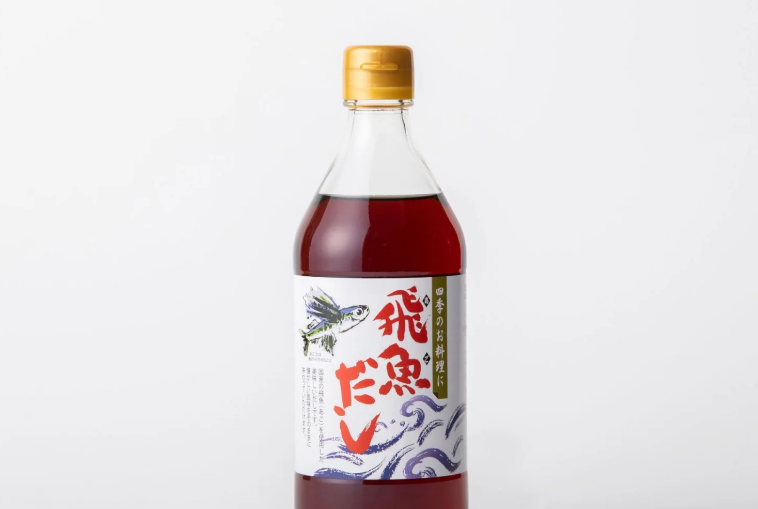
You can kill two birds with one stone and stock up on an essential while treating yourself to a regional product of the Oki Islands, all thanks to the Flying Fish Soup Stock. As a soup stock or dashi, it is used in a wide range of Japanese dishes. The regional flair comes from its main ingredient: locally caught flying fish, one of the highlights of the islanders’ cuisine. This with the soy sauce base and the umami of kombu kelp, blends into a rich flavour that goes well with almost anything. Some even add a dash to their pasta or Chinese-style fried rice.
Flying Fish Soup Stock is a liquid sold in bottles of 150 ml and 500 ml. Upon opening the product, it is ready for use and has a shelf life of about one year.
- Where can you buy it?
Ama Town: Tsunakake, Kinnya Monya Center
Online: https://amabussan.shop-pro.jp//?mode=f1
Tobikko
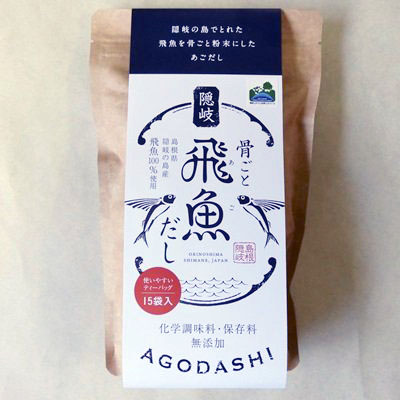
For those who would rather have their soup stock in a powder form; or those who crave a simpler taste; or those for whom both of the above are true, Tobikko is a perfect choice.
This soup stock contains only one ingredient: no salt, no additives, just the flying fish, locally caught and naturally processed. Once out of a fisherman’s net, it is headed and gutted, then boiled, dried and at last, ground to powder. The finishing product is a low-fat, healthy stock, great for miso soup and simmered dishes, just to name a few.
Tobikko is available in a 120 g pack. The stylish, minimalistic packaging was designed with the financial support of the Oki Islands Geopark Management Bureau.
- Where can you buy it?
Okinoshima Town: Kyōmiya Bunten
Online: https://yokoji.net/?pid=25427462
Yellowtail Green Curry
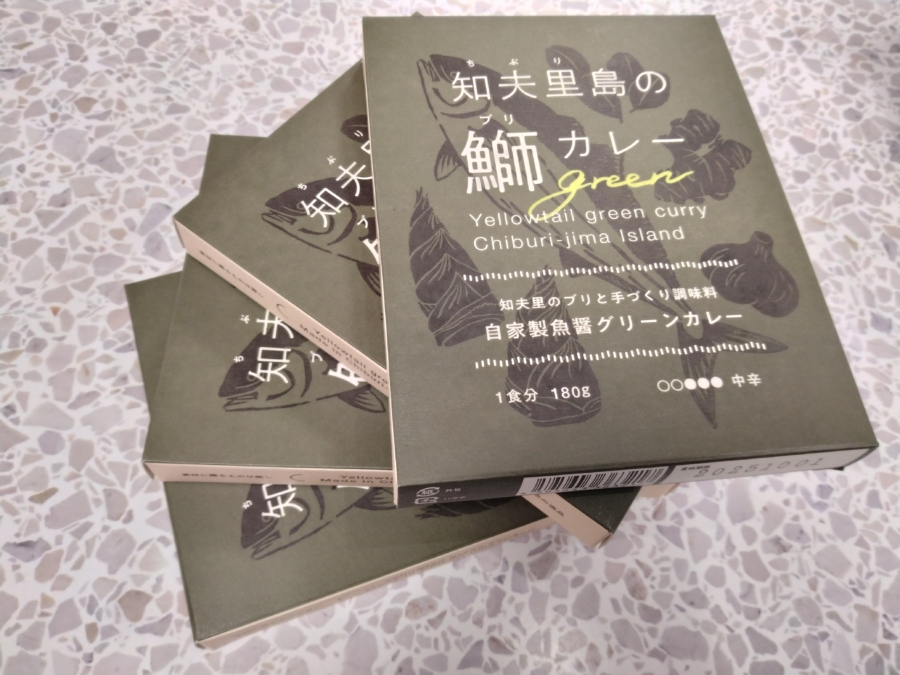
One can argue that due to its ingredients, Yellowtail Green Curry is a quintessential Chibu Village product. There is the yellowfish, processed on the day it was caught by the local fishermen in the waters near their home island. There are bamboo shoots, harvested in Chibu Village, as well as fish sauce and salt, both produced there as well. Add aromatic green curry paste and sweet coconut milk from Thailand and the result is a rich, mouthwatering dish.
Yellowtail Green Curry is sold in a single portion box. It only takes a couple of minutes to prepare. Once boiled or microwaved, serve it with hot rice and enjoy a quick dinner filled with memories of Chibu Village.
- Where can you buy it?
Chibu Village: Tourism Association
Nishinoshima Town: Many Dale (2nd floor of Beppu Port Terminal)
Salt

Salt is a non-negotiable in any kitchen cupboard and, as such, provides an easy way to enrich your everyday cooking with the flavours of the Oki Islands, especially since the islands offer quite a selection of products under the umbrella of salt, all made from seawater using traditional techniques.
First off, there is Ama-no Shio. It is available in four sizes, from a packet of 40 g to a bag of 1 kg, and the packaging boasts a mark proving this salt has been blessed at Oki Shrine, Ama Town. As a condiment, it compliments salads, onigiri rice balls and baked fish.
Then, there are five blends of salt, each incorporating either hibiscus, flying fish, bonito, Japanese pepper or togarashi chilli pepper. Sold in a jar of 50 g, they each have a different flavour, but as a rule of thumb, they are recommended for dishes with strong, distinctive tastes.
Last but not least, there is the Salann Oki Flake Salt with its characteristic big grains. It is an obvious choice for meat and fish dishes, but a pinch compliments sweet treats. It is available either in a jar or in bulk.
- Where can you buy it?
Ama Town: Kinnya Monya Center, Tsunakake
Candle-Island Seaweed Salt
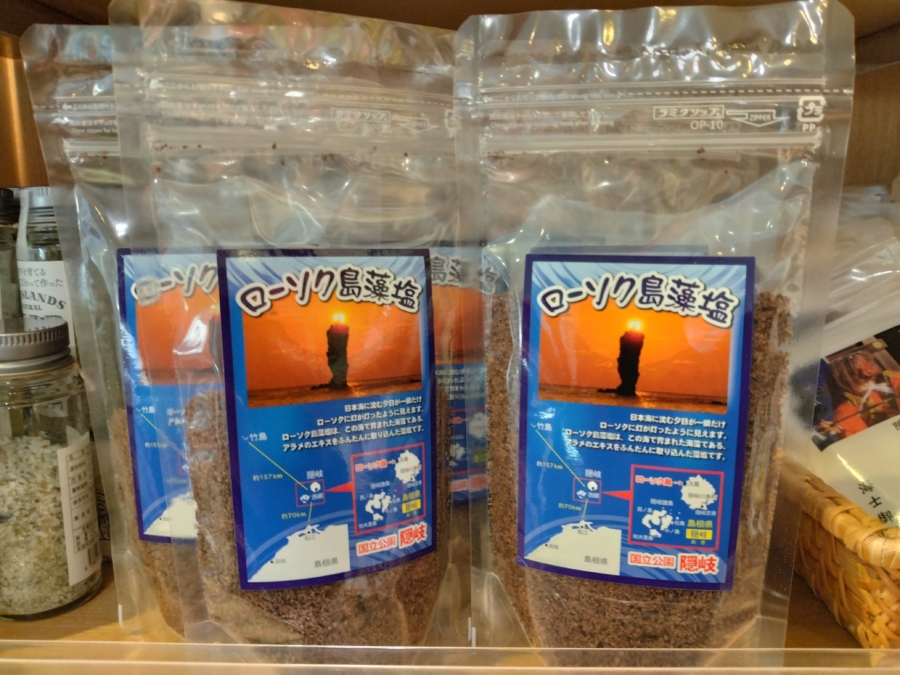
The islanders employ one more method of making salt―with the use of seaweed. It goes like this: locally sourced arame seaweed simmers in a pot of seawater, concentrating the solution. Then, it air-dries on the breeze, which further evaporates the moisture. The result of this process, done entirely by hand, is a harvest of unique, brown salt, enriched with seaweed nutrients.
Candle-Island Seaweed Salt is a great condiment for baked fish and fried dishes, especially tempura. It compliments salads, too. It is sold in bags of 100 g, adorned with a picture of its namesake.
- Where can you buy it?
Okinoshima Town: Saigō Port Souvenir Shop, Kyōmiya Bunten, Oki Airport
Island Scent Oki Algae Salt Rice
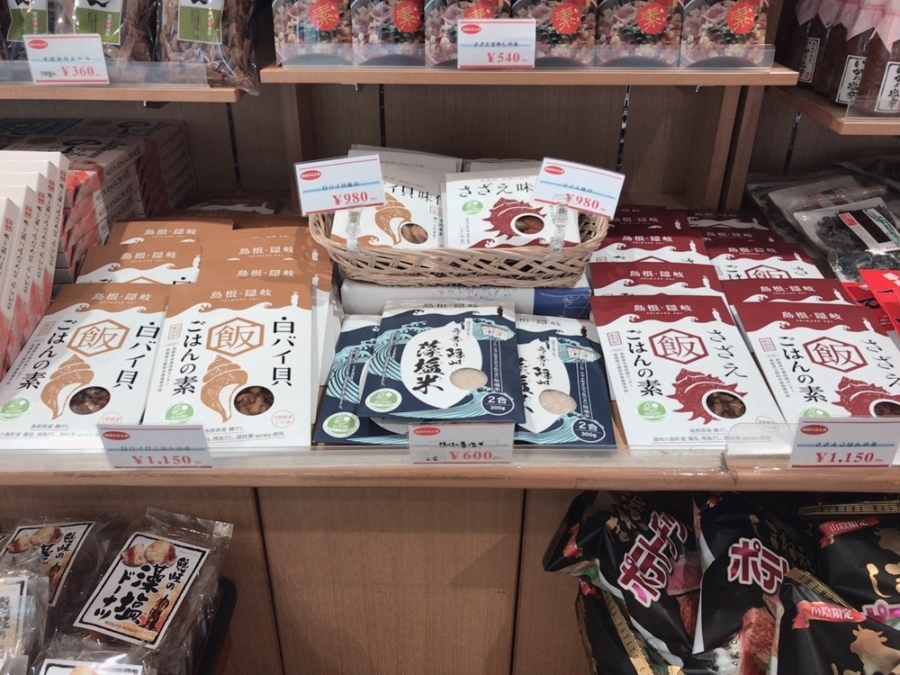
Yes, Oki Islands are very hilly and yes, it is still possible to cultivate rice here. For proof, look no further than Island Scent Oki Algae Salt Rice. It grows naturally without relying on pesticides or chemical fertilizers. Instead, it takes nutrients from the alkaline soil and nationally recognised spring waters of Oki. And of course, from the salt. In a callback to the traditional farming practices of the islanders, farmers sprinkle their fields with salt produced from locally sourced algae. That way, they enrich the soil and by extension―the rice.
All this results in environment-friendly crops, rich in minerals and unparalleled in taste. No wonder Island Scent Oki Algae Salt Rice is now one of the products certified by the Oki Islands Geopark Management Bureau.
- Where can you buy it?
Okinoshima Town: Saigō Port Souvenir Shop, Kyōmiya Bunten
Oki Beef
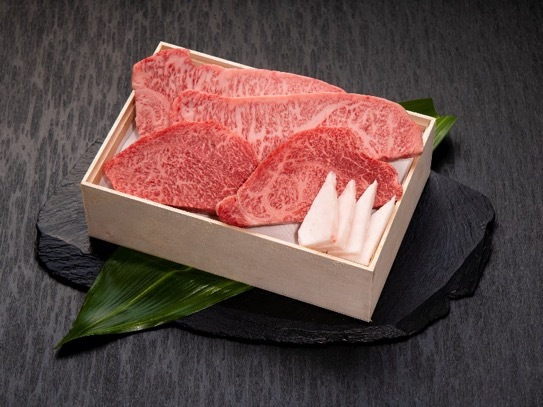
Have you heard about Wagyu beef? In recent years, it has garnered attention for its high quality and exquisite taste. One of its many brands is Oki Beef, sourced from the cattle born and raised in the hilly meadows of the Oki Islands.
Any red meat lover would only need to look at the marbling to know that Oki Beef is a must-try food item, even though visuals alone cannot do its tenderness justice. If you haven’t had a chance to try it during your visit to the islands―or you had a chance and would care for an encore―you can order it online. A small business in Ama Town offers sets for steaks, barbeque and sukiyaki-style dishes, cut from the loin, tenderloin, upper ribeye and other parts. Perfect for a lavish, sinfully delicious dinner to treat yourself and your loved ones.
- Where can you buy it?
Online: Okigyu (only within Japan)
Miscellaneous
The Everything Else section is a treasure trove of unique products, each telling a different story about the nature, culture and people of the Oki Islands.
Faroma
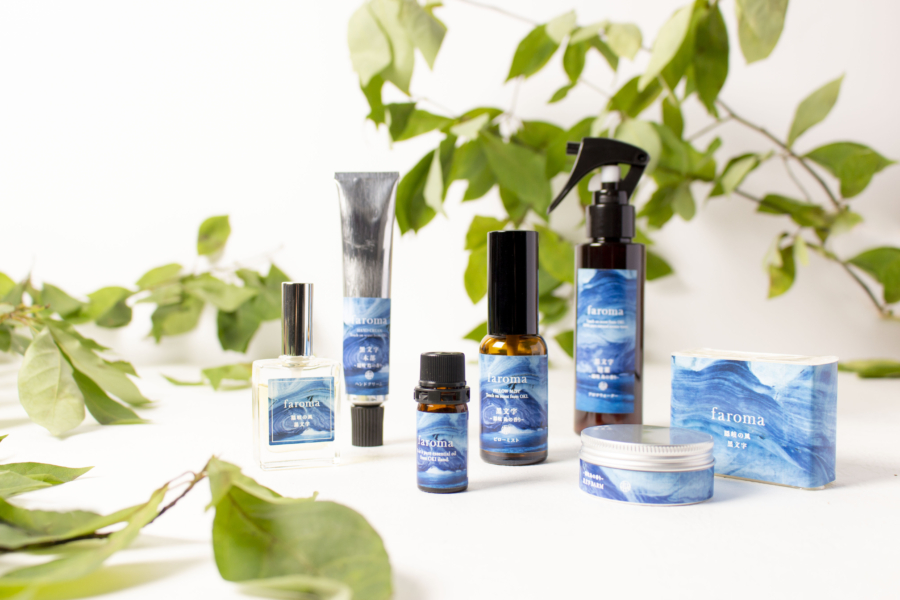
For a quick recap: fukugi or kuromoji is a type of aromatic, evergreen shrub in the Lindera genus. In the Oki Islands, people use its leaves in their everyday lives and have praised its health benefits and relaxing scent since long ago.
Taking that into consideration, it was only a matter of time before someone would develop a line of fukugi-based products―just like ANALOG did with the brand Faroma. The lineup features essential oils, perfume, business card incense, pillow mist, balm, hand cream, soap, tea and aromatic distilled water. Essential oils and aromatic distilled water come in two types: wooden part fragrance and leaves/branches fragrance, and yes, there is a difference. The former carries sweeter notes, while the latter is crisp and refreshing. All Faroma brand products are certified by Oki Islands UNESCO Global Geopark.
Although the company’s headquarters is elsewhere, it operates a distillery in Okinoshima Town, where locally sourced fukugi is processed. In this way, it bridges the islands with the city, introducing scents of the Oki Islands to the world.
- Where can you buy it?
Ama Town: Tsunakake, Ento Hotel
Okinoshima Town: Saigō Port Souvenir Shop, Kyōmiya Bunten, Azuma Gift Shop, Oki Plaza Hotel
Fukugi Bath Bags
Back in the day when tubs heated from beneath were still in popular use, people in the Oki Islands would drop chopped fukugi leaves and branches into the hot water to enjoy a fragrant bath.
A small company in Ama Town decided to bring this custom back with their Fukugi Bath Bags. Sold in a pack of two, the bags are full of locally harvested leaves and branches. You can drop one into a tub once it is filled with water and let the fukugi do its magic. Feel free to add salts or other bath products of your choosing for an ultimate home spa experience. Alternatively, you can repurpose the bag as a potpourri sachet. If you sneak one under your pillow, its fresh, relaxing scent will lull you into a peaceful slumber.
- Where can you buy it?
Okinoshima Town: Kyōmiya-bunten
Online: https://jigemonshop.net/?pid=156978181
Fukugi Herb Tea
An assortment of fukugi-based products would not be complete without these two types of herb tea. The one in a bag is a selection of loose branches; the one in a box is a blend of branches and leaves in teabags. Neither of them contains any caffeine, which makes both a great candidate for a cosy evening cup of tea.
So which one should you choose?
Casual tea drinkers might naturally gravitate towards the one sold in teabags. Elegant packaging with a prominently displayed Japanese character for good luck, a nod to the local name for the Lindera plant (fukugi loosely translates to “here comes good fortune”), makes it a great choice for a gift, too.
On the other hand, seasoned tea lovers might be interested in the one with loose branches. Only a spoonful of product is needed for one litre of water, so once you bring it to a boil and let it simmer for a few minutes, you will have a whole pot of freshly brewed hot beverage in a charming shade of pink.
- Where can you find it?
Ama Town: Tsunakake, Kinnya Monya Center
Okinoshima Town: Kyōmiya-bunten, Mori Sake-ten
Craft Beer
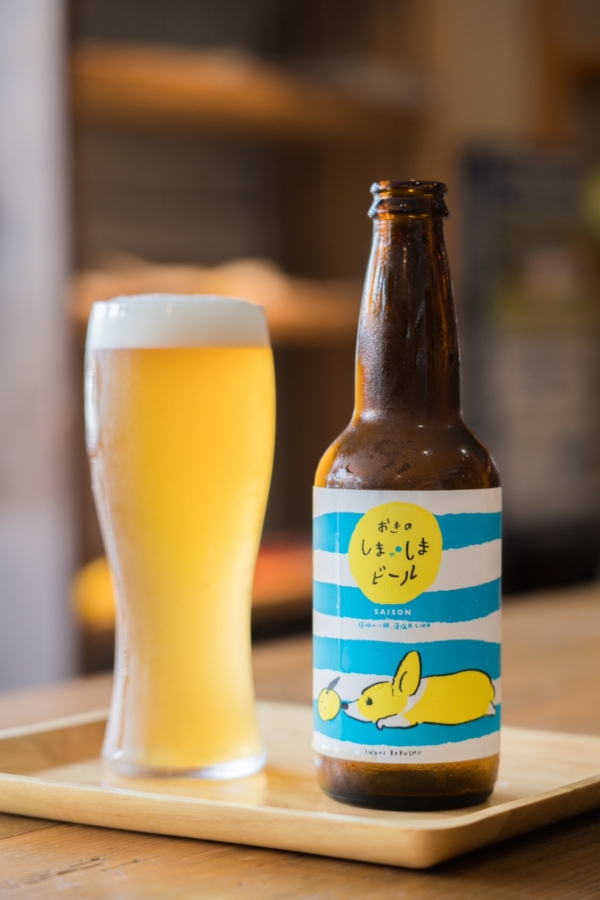
What can be better than a cold beer after a long, summer day spent exploring the islands?
A cold craft beer! Even more so if you can sip a few in a chic café while nibbling on an assortment of snacks or treating yourself to a dessert!
Two different brews await in Okinoshima Town, both made with locally sourced ingredients and produced in collaboration with Iwami Local Whole Brewery in mainland Shimane Prefecture. Fukugi Beer, as the name suggests, is yet another product that incorporates the islanders’ beloved plant. It also carries notes of Japanese pepper but has a delicate, refreshing taste. On the other hand, the list of ingredients for Oki-no-ShimaShima includes hassaku fruit and rice cultivated with the use of seaweed salt. The adorable corgi on the label is the honorary manager at the café-slash-souvenir shop that developed this craft beer.
- Where can you buy it?
Okinoshima Town: Kyōmiya Bunten (Oki-no-Shima Shima), Café Yuragi (Fukugi Beer)
Oki Sake Brewery Products
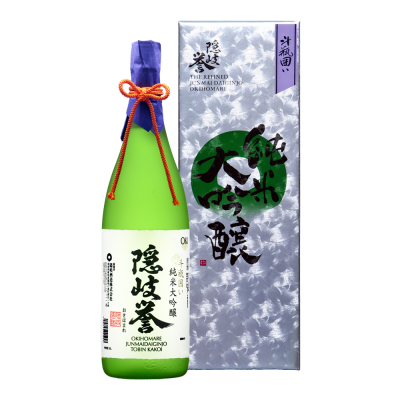
Water and rice are two key ingredients for sake, or Japanese rice wine. Since the Oki Islands enjoy a high quality of both, the islanders have long engaged in sake brewing. Over the years, many small businesses have operated on the islands, but in time, they consolidated into one company. That company is Oki Sake Brewery.
The company produces a variety of liquors, most prominently the many types of sake under the flagship brand name “Oki Homare”. Amongst those, two products deserve a shoutout. One of them is Jōkyū-no-en, made with highly praised Tengawa-no-mizu spring water from Ama Town and the rice that was cultivated there, too. These links to Ama Town are reflected in the product name which is a play on the word Jōkyū-no-ran, or Jōkyū Rebellion―an event in the aftermath of which the retired emperor Go-Toba was exiled to the island.
Another one is Muromachi-no-junmaishu, a liquor recreated from a 13th-century recipe that quite literally links the past with the present. It has gained recognition overseas with multiple prizes won in a prestigious French sake competition called Kura Master.
Other than sake, the brewery offers hard liquor shōchū made with seaweed and hassaku fruit liqueur.
- Where can you buy it?
Ama Town: Kinnya Monya Center
Nishinoshima Town: Ando-honten
Okinoshima Town: Sunterrace Shopping Center, Saigō Port Souvenir Shop, Mori Sake-ten, Misumi
Online: Oki Sake Brewery
Wooden straws
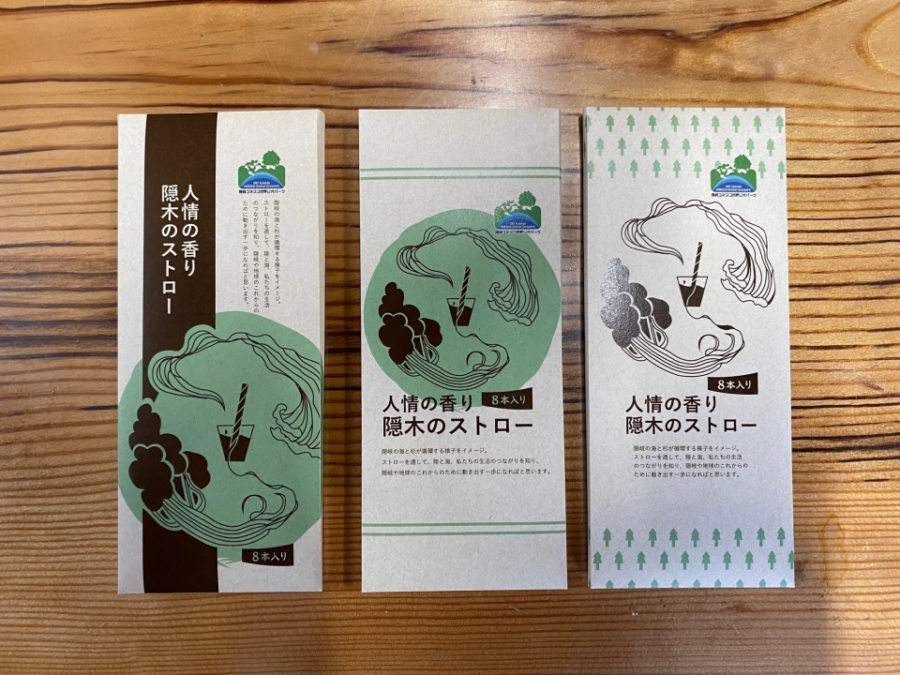
Why sip your drink with single-use plastics when you can use a wooden straw instead?
Especially the ones offered by Woodhill Oki, a business in Okinoshima Town. Sold in a box of eight, these straws are made from locally harvested timber. They are resistant to heat and, of course, can be used multiple times. With a simple yet elegant design, they are a great gift idea for anyone who cares about the natural environment and likes their souvenirs to have practical applications. These wooden straws are also a certified product of Oki Islands UNESCO Global Geopark.
- Where can you buy it?
Okinoshima Town: Saigō Port Souvenir Shop
Ceramics with natural ash glaze
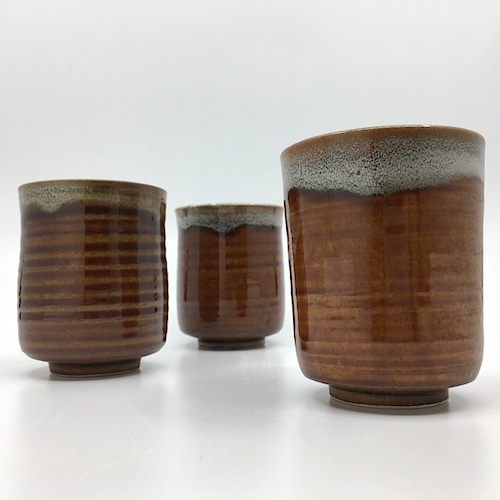
The Oki Islands don’t seem like a place to be for pottery enthusiasts, do they?
Well, Nishinoshima Town begs to differ, seeing as it is home to the Takuhi-gama Kiln. The artisans employ natural materials sourced from the foothills of Mt Takuhi and the seaside and turn them into works of art. From modest teacups to sophisticated flower vases, from contemporary coffee mugs to traditional tea bowls and sakazuki sake cups, these handcrafted items are connected to the culture and deep history of the islands. Their status as certified products of Oki Islands UNESCO Global Geopark is very much deserved.
- Where can you buy it?
Nishinoshima Town: Takuhi-gama
Online: Takuhi-gama
Dyed Shawl
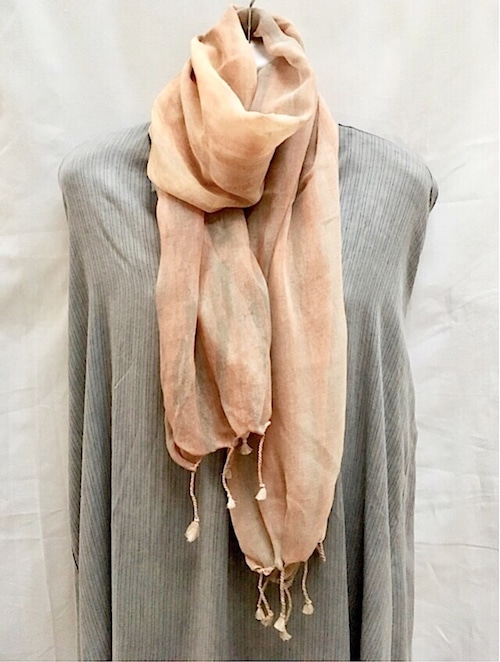
The dyed shawl is another handicraft of the Takuhi-gama Kiln artisans. They dye the fabrics using natural ingredients, such as locally sourced soil. Its vibrant colours are a result of geological processes that have shaped the face of the islands; now they echo in the gentle shades that tint the shawls.
High-quality and chic, rooted in the geological history of the islands and Earth itself, the dyed shawl is a thoughtful gift and keepsake from Nishinoshima Town and a certified product of Oki Islands UNESCO Global Geopark.
- Where can you buy it?
Nishinoshima Town: Takuhi-gama
Online: Takuhi-gama
T-shirts and Polo Shirts
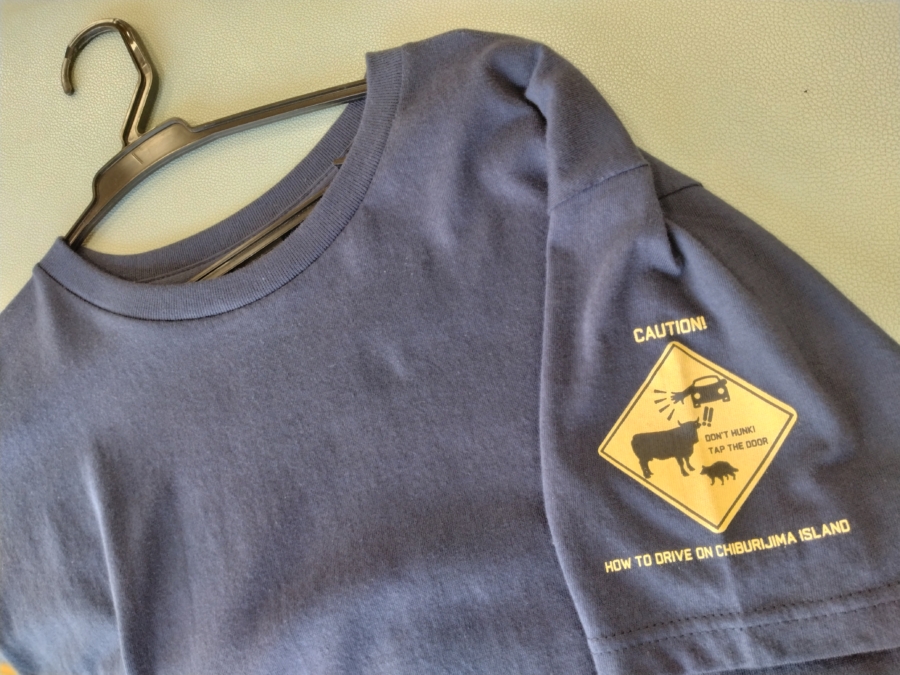

To call them the pinnacle of contemporary Oki Islands fashion would not be an overstatement because every respectable islander seems to own one of these shirts, if not a dozen. And there is much to choose from, seeing as every island developed a product with its town (or village)-specific design.
In Okinoshima Town, you can find classic, navy polo shirts and T-shirts adorned with designs inspired by the folk song “Oki Shigesa-bushi”. Bold white characters recite the lyrics and the simple line art depicts dancers.
In Nishinoshima Town, garments pay homage to local sights and characters. If it’s red line art on a black fabric, then it features Takuhi Shrine. Others feature the local Japanese sake brewery products. And have you seen the town’s character, Katchan? If you’d like, you can get a polo shirt with this friendly squid, too.
In Ama Town, cotton shirts are all the rage with designs featuring the retired emperor Go-Toba and the folk song “Kinnya Monya”. Then, there is the eye-catching pink shirt developed by the souvenir shop Tsunakake and, of course, the polo shirt that proudly displays the town’s catchphrase: “There is nothing we don’t have.”
Last but not least, Chibu Village comes up with new designs for its shirts every year and then puts them on breathable cotton and quick-dry polyesters. Repeat visitors should stay tuned!
- Where can you buy it?
Chibu Village: Tourism Association
Ama Town: Tsunakake, Kinnya Monya Center
Nishinoshima Town: Ando-honten, Nishonoshima Town Montbell Shop, Nihonkai Oki Katsugyo Club (Nishinoshima Town Tourism Exchange Center, Uragō Port)
Okinoshima Town: Saigō Port Souvenir Shop
Maniac Figures
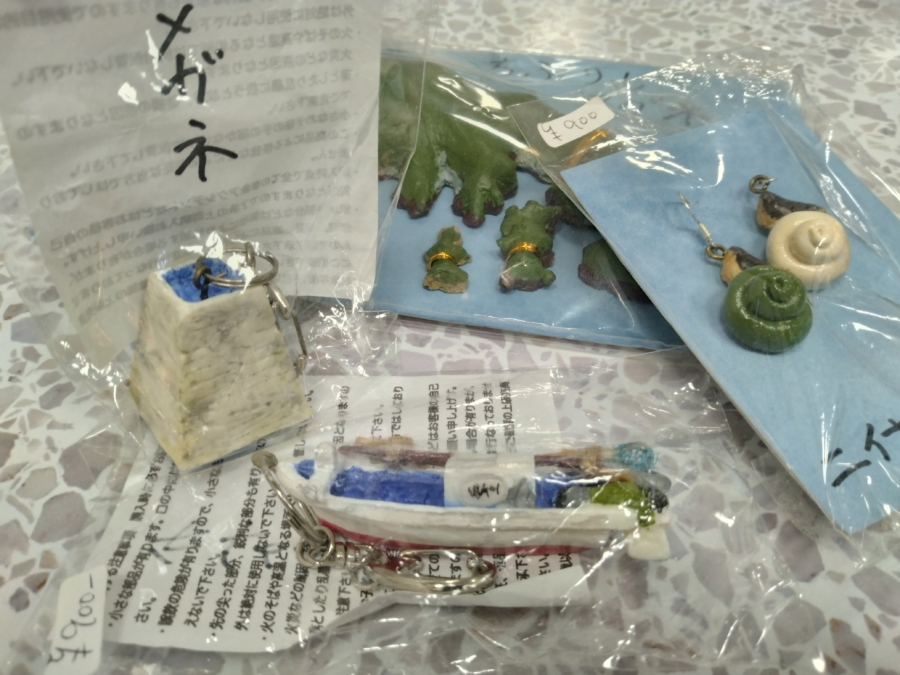
Are you looking for a keepsake from Chibu Village?
If so, you should check out Maniac Figures, a collection of keyholders and fridge magnets. They come in many different shapes: a boat, a fisherman’s equipment, marine life and even the island itself, capturing the essence of the islander’s life. There are no two pieces alike. A Chibu native living in Osaka handcrafted them all and once they introduced them back home, the goods became an instant hit. They are highly recommended for anyone looking for a casual but unique souvenir.
- Where can you buy it?
Chibu Village: Tourism Association
Shamoneko
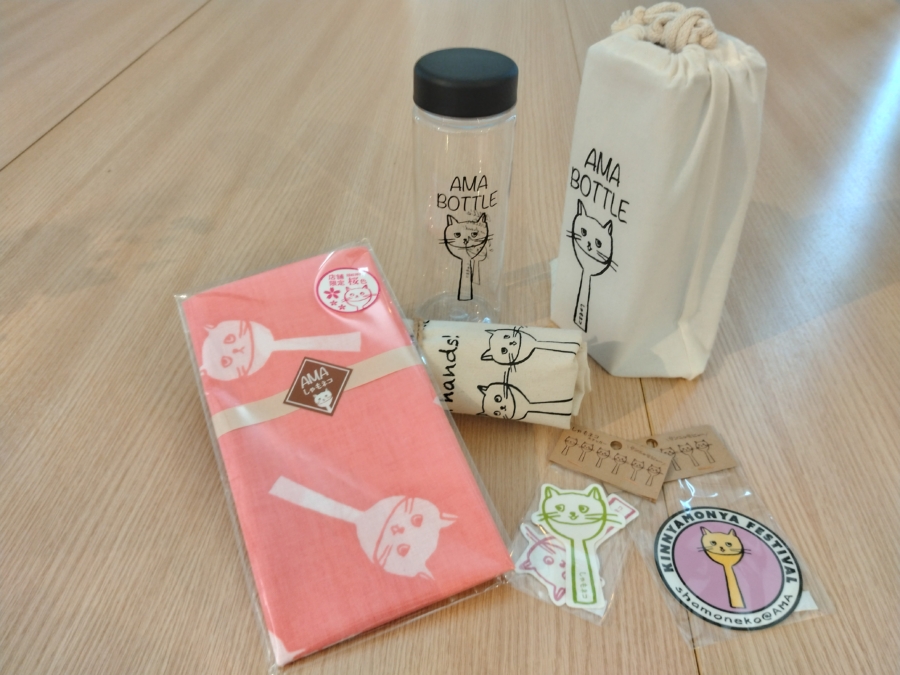
Shamoneko is a brand of products featuring an adorable cat-shaped rice scoop. Why the rice scoop? Because in Ama Town, it is a culturally significant item, held when dancing to the beloved folk song “Kinnya Monya”. Why the cat? Because the designer who worked on these products was a cat owner themselves.
The Shamoneko goods include stickers, tote bags, tenugui towels, water bottles, hair accessories, and keyholders. There is even green tea harvested in Shimane Prefecture that can be enjoyed hot or cold. Somewhere amongst them awaits a perfect gift for yourself or your friends.
- Where can you buy it?
Ama Town: Tsunakake, Kinnya Monya Center
What are Geopark Certified Products?
The Oki Islands: its nature, its culture, and its people.
All of these things take shape as Oki Islands UNESCO Global Geopark Certified Products.
These products embody the Oki Islands, incorporating ingredients and skills rooted here to tell a unique story.
Certified Products are only chosen from products that have all of these elements.
Among them, you will find products that have used the Oki Islands UNESCO Global Geopark Package and Design Support Program to refine their charming qualities and share with a wider audience the things that make the Oki Islands great.
